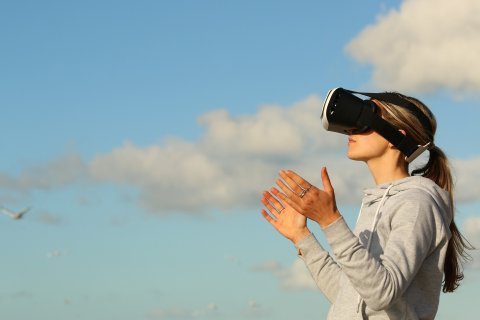Virtual and Augmented Reality Technologies

Virtual reality (VR) and augmented reality (AR) are changing education. Both tools have the potential to create immersive learning experiences and allow for deep engagement. They also promote exploration and a hands-on approach that aids in learning and retention. In addition, VR and AR help with understanding complex concepts.
Using Google Cardboard, you can adopt VR into your classroom very easily. Google Cardboard is a simple cardboard box into which you insert a smartphone. For the virtual or augmented experience, you need to download apps to your smartphone that have the content you want to teach. Here are some of the latest VR and AR tools available for classroom use.
Virtuali-Tee
Virtuali-Tee takes students on an augmented and virtual journey into the human body. The app requires one student to wear a specially-made T-shirt while another student uses a smartphone to see a map of various internal body parts, such as the lungs, on the shirt. The T-shirt can be purchased on Curiscope for $29.99 and the app can be downloaded from the App Store or Google Play.
TimeLooper
TimeLooper uses augmented and virtual technologies to take you back in time. With this app, your students can relive historical events that took place all over the world, viewing the sites as they are today and learning why these events made those locations iconic. You can use this app with Google Cardboard for a virtual experience. For an augmented experience, while visiting one of the sites, you can simply align a smartphone against your surroundings to see the different time periods. TimeLooper currently has augmented experiences for London, New York, Washington DC, Budapest, Berlin, and İzmir. One New York experience lets you can take your students to Ellis Island to follow a Polish family’s journey across the Atlantic Ocean. You can download the app from the App Store or Google Play.
Woofbert
Take your students on a virtual trip to an art gallery. Woofbert gives virtual tours of museum art collections and cultural sites all over the world. Their VR collections are aligned with art history curricula. Users can tour galleries and listen to narrations about the art they see.
Unimersiv
This app includes a large collection of educational VR experiences. Your students can learn about the human brain, dinosaurs, and space. You will find educational content for all age groups. You can download the app from Google Play.
Lithodomos VR
Lithodomos VR reconstructs Jerusalem during the Second Temple, giving students the chance to see Jerusalem as it looked during the days of Beit HaMikdash HaSheni - before it was destroyed by the Romans in 70 CE. The app uses up-to-date archaeological research about the Temple Mount and includes a tour of the area around Jerusalem's Western Wall, where the ancient stones that surrounded the city's Temple Mount can still be seen. You can use this VR in the classroom and also when visiting the area in person, which lets students compare what they see with the app’s reconstruction. The app sells for $1.99 on Google Play, and $2.99 in the App Store.
zSpace
zSpace is an all-in-one desktop virtual reality technology that helps students to learn math, physics, engineering, and biology by manipulating virtual 3D objects such as brains. zSpace is built for pair and group work, allowing students to “learn by doing” in a virtual environment.

